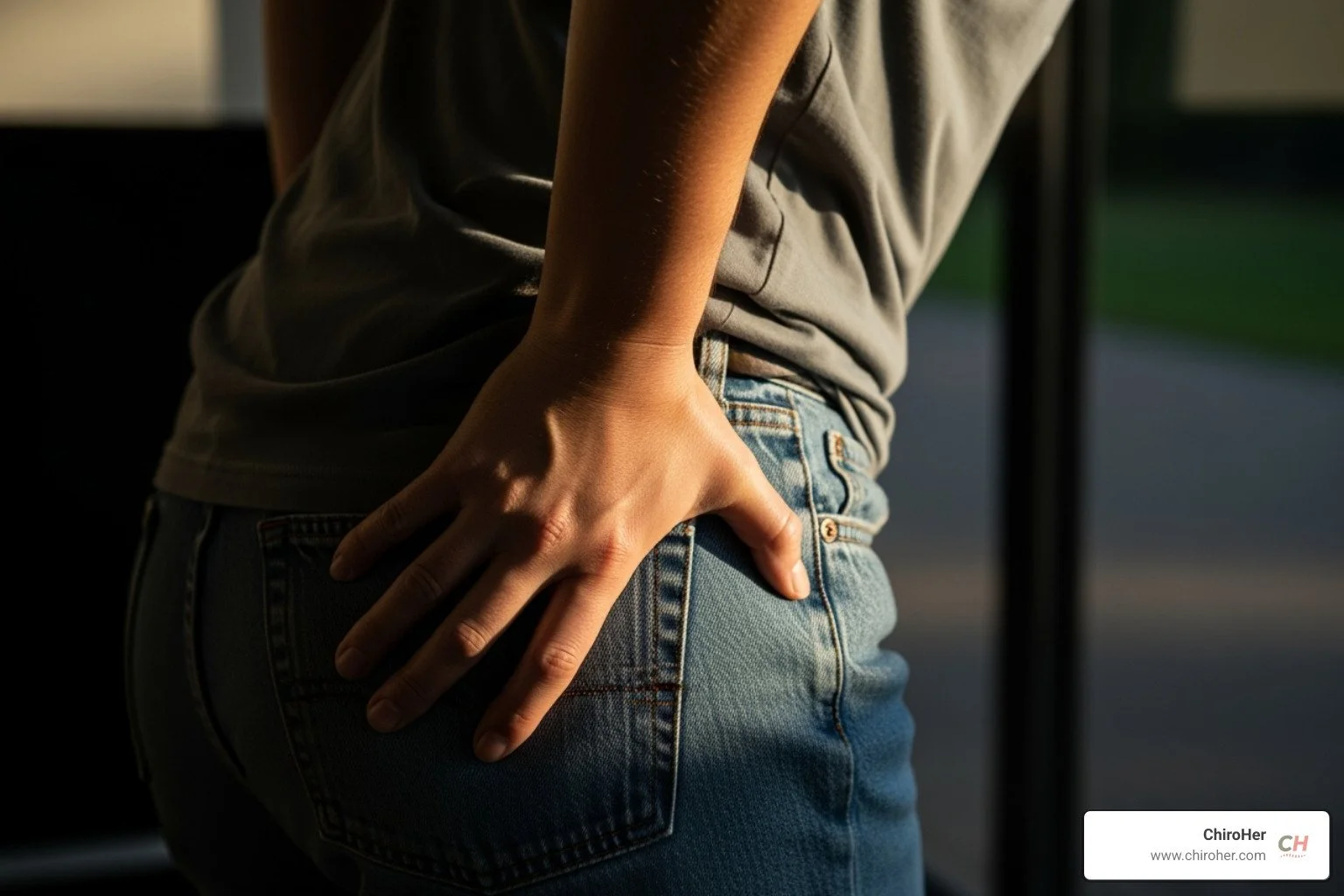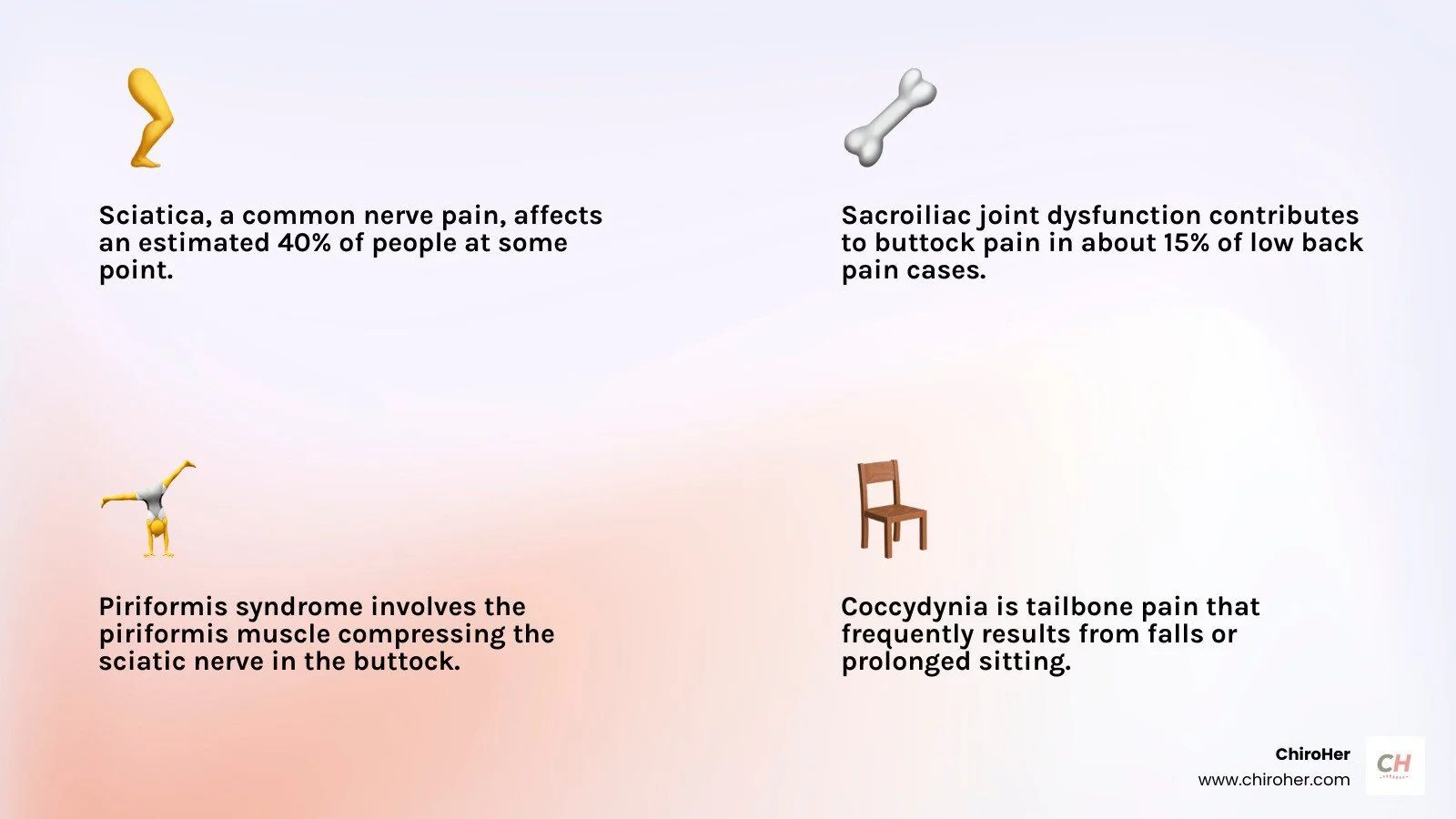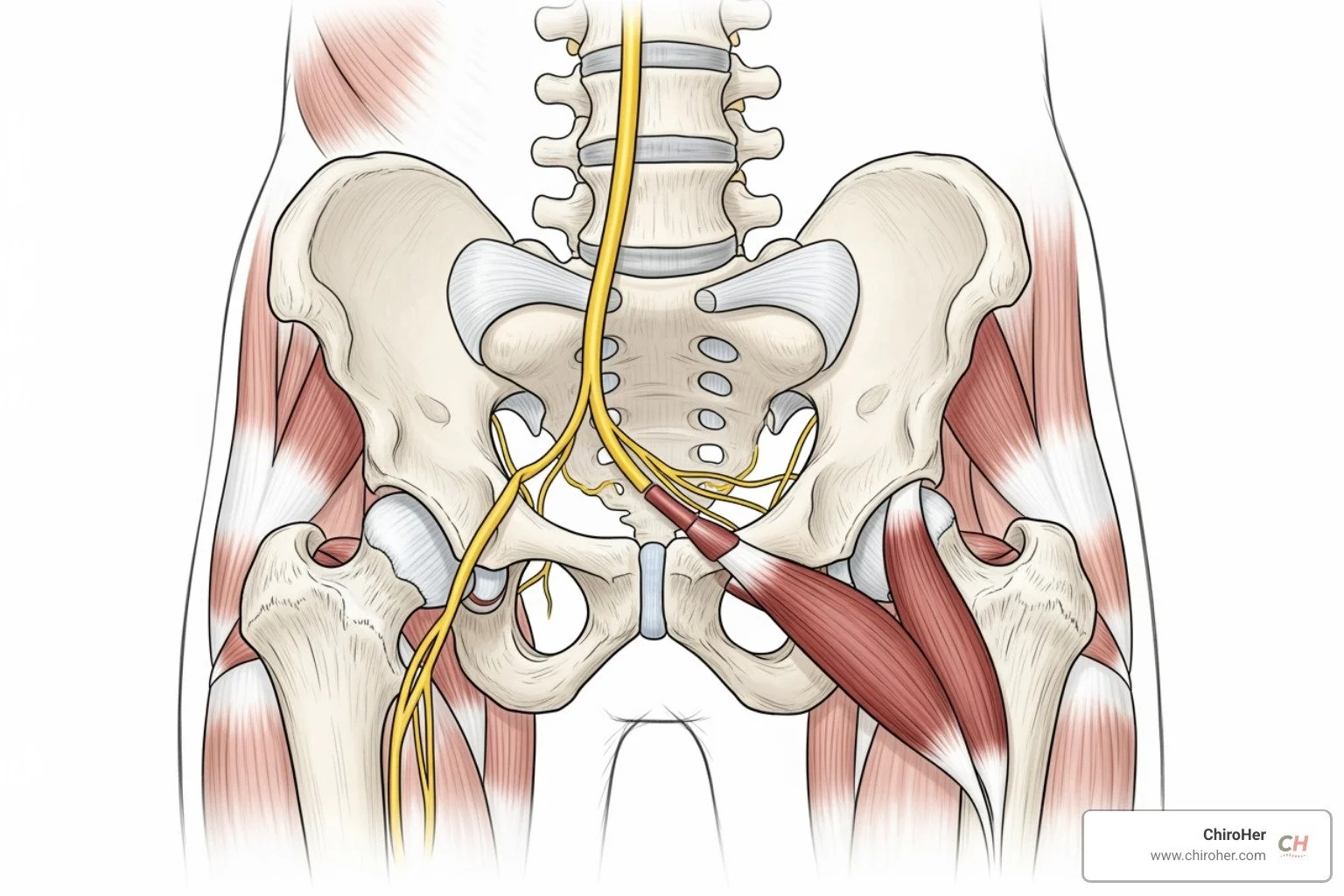From Mild Ache to Sharp Pain: Understanding Buttock Discomfort
Why Buttock Discomfort Affects So Many People
Discomfort in buttocks is a surprisingly common issue. While you may not think about your buttocks often, you'll certainly notice when they start to hurt. The pain can range from a mild ache to a sharp, shooting sensation that makes sitting, walking, or sleeping difficult.
Common causes of buttock discomfort include:
Sciatica: Nerve pain affecting an estimated 40% of people.
Piriformis syndrome: Muscle compression of the sciatic nerve.
Coccydynia: Tailbone pain from falls or prolonged sitting.
Ischial bursitis: Inflammation from sitting on hard surfaces.
Sacroiliac joint dysfunction: Affects about 15% of people with low back pain.
Hip arthritis: Joint wear that can radiate pain to the buttocks.
Buttock pain is tricky because it often involves the sciatic nerve, which runs from your lower back, through your buttocks, and down each leg. Irritation to this nerve or surrounding muscles can cause pain in multiple places at once.
Hi! I'm Dr. Michelle Andrews. At ChiroHer in Oklahoma City, I've helped hundreds of patients find relief from buttock discomfort. My experience with prenatal patients and athletes has shown me how this issue can disrupt daily life, which is why a proper diagnosis is so important.
Common Causes and Symptoms of Discomfort in Buttocks
Understanding why your buttocks hurt can be a puzzle. The pain might originate where you feel it, or it could be referred from your lower back, hips, or pelvis. These areas are connected by a complex network of muscles, nerves, and joints. When something in this system is off, discomfort in buttocks can be the first sign. Pinpointing the cause is the key to effective treatment.
Nerve-Related Pain: Sciatica and Piriformis Syndrome
Nerve irritation is a frequent cause of persistent discomfort in buttocks. When a nerve is pinched or compressed, it can create symptoms ranging from annoying to severe.
Sciatica and the Sciatic Nerve Sciatica is not a condition but a symptom of sciatic nerve irritation. This nerve, the longest in your body, runs from your lower back, through your buttocks, and down each leg. Sciatic pain is often a sharp, shooting sensation down the back of the leg, sometimes with numbness or tingling. It can worsen with sitting, sneezing, or coughing. According to scientific research, about 40 percent of people experience sciatica in their lifetime.
Herniated Disc A common cause of sciatica is a herniated disc in the lower back. Spinal discs have a soft center that can push through the outer layer and press on the sciatic nerve. Age, heavy lifting, and repetitive movements increase this risk.
Piriformis Syndrome Sometimes the problem is the piriformis, a small muscle deep in the buttocks. If this muscle becomes tight or inflamed, it can squeeze the sciatic nerve, causing sciatica-like symptoms. This is known as piriformis syndrome and is common in people who sit for long periods or are very active, like runners.
Comparing Sciatica and Piriformis Syndrome
Feature Sciatica Piriformis Syndrome Origin of Compression Typically spinal (herniated disc, spinal stenosis) Piriformis muscle in the buttock Primary Location Lower back, radiating down leg Buttock, radiating down leg Causes Herniated disc, spinal stenosis, bone spurs Muscle spasm, tightness, injury, overuse Diagnosis Often involves spinal imaging (MRI) Clinical examination, specific tests Prevalence Affects 40% of people at some point Causes 0.3%-6% of lower back pain
For more on nerve-related buttock pain, see our articles on Low Back Sciatic Pain and how a Chiropractor Helps with Sciatica.
Discomfort in Buttocks from Injury and Pressure
Direct injury or prolonged pressure can also cause discomfort in buttocks, making sitting and walking difficult.
Coccydynia (Tailbone Pain) Coccydynia is pain in the tailbone (coccyx) that can range from a dull ache to a sharp pain. It often worsens when sitting or moving from sitting to standing. Common causes include falls, childbirth, and prolonged sitting on hard surfaces. Learn more from the NHS about Coccydynia.
If you think pelvic alignment is a factor, our resources on What a Misaligned Pelvis Feels Like and Pelvic Pain in Pregnancy may be helpful.
Ischial Bursitis (Weaver's Bottom) This condition is an inflammation of the bursa, a fluid-filled sac near your "sit bone." It causes pain directly over the sit bone that worsens with prolonged sitting on hard surfaces.
Bruising from Falls or Direct Impact A simple bruise from a fall or injury can cause significant tenderness and pain. Most bruises heal within a couple of weeks, but severe or persistent pain should be evaluated.
Other Conditions: Arthritis and Sacroiliac (SI) Joint Dysfunction
Chronic discomfort in buttocks can also stem from inflammation or wear-and-tear in your joints.
Hip Arthritis Pain from an arthritic hip joint often radiates to the buttocks, groin, and thigh. It typically causes an aching pain that is worse in the morning or after inactivity, along with stiffness. Johns Hopkins Medicine offers more information on this condition.
Degenerative Disc Changes As we age, our spinal discs can thin and lose water content. These changes can lead to chronic lower back pain that radiates to the buttocks, often worsening with sitting or bending.
Sacroiliac (SI) Joint Dysfunction Your SI joints connect your spine to your pelvis. When they become inflamed or move improperly, they can cause pain in the lower back and buttock, sometimes mimicking sciatica. SI joint dysfunction affects about 15 percent of people with lower back pain and can be common during and after pregnancy. We use techniques like muscle energy methods to restore proper function, as discussed in our article on Muscle Energy for SI Joint.
Pelvic Floor Dysfunction When the pelvic floor muscles are too tight or weak, they can cause pain in the buttocks and inner thighs. This can result from childbirth, chronic straining, or stress.
Diagnosis, Treatment, and Finding Lasting Relief
Understanding the cause of your discomfort in buttocks is the first step. From there, we can create a treatment plan that addresses the root of the problem, not just the symptoms.
At ChiroHer, I know that every patient's situation is unique. That's why we take the time to understand your specific condition before beginning treatment.
How is Buttock Pain Diagnosed?
Diagnosing the cause of discomfort in buttocks requires a thorough approach, as symptoms of different conditions often overlap.
Medical History Review: We'll start by discussing your symptoms, when the pain began, what makes it better or worse, and how it affects your daily life. Details about your work, exercise habits, or recent injuries are also important clues.
Physical Examination: I will observe how you move and gently palpate the area to find muscle spasms or tender spots. We'll perform range-of-motion tests for your hips, spine, and pelvis to identify limitations or pain triggers. Specific orthopedic tests help differentiate between conditions like sciatica and piriformis syndrome.
Imaging (When Needed): While not always necessary, imaging can provide a deeper look. X-rays show bone structure, helping to identify arthritis or alignment issues. An MRI provides detailed images of soft tissues like discs and nerves, which is useful for suspected herniated discs or nerve compression.
Learn more about our methods in our articles on What a Chiropractor Does and our Guide to Spinal Adjustments.
Home Care and Lifestyle Changes for Discomfort in Buttocks
While professional care is key, you can take steps at home to manage discomfort in buttocks and support your recovery.
Ice and Heat: Use ice for 15-20 minutes on fresh injuries or during flare-ups to reduce inflammation. Use heat for chronic aches and muscle tension to improve blood flow and relax muscles.
Gentle Stretching: Regular, gentle stretching can relieve tight muscles. Focus on piriformis, hip flexor, and hamstring stretches. Find examples in our guides to Sciatic Nerve Stretches and Stretches for a Misaligned Pelvis.
Posture Correction: When sitting, keep your feet flat on the floor and avoid slumping or crossing your legs. When standing, distribute your weight evenly.
Ergonomic Cushions: A doughnut cushion can relieve tailbone pain, while a wedge cushion can improve pelvic alignment and reduce strain while sitting.
Avoid Prolonged Sitting: Stand up and move around every 30-45 minutes to prevent muscle stiffness and pain.
Professional Treatments and When to See a Chiropractor for Discomfort in Buttocks
Home care is helpful, but some situations require professional attention.
Red Flag Symptoms: Seek immediate medical care if you experience sudden, severe pain with leg weakness, loss of bowel or bladder control, or rapidly spreading numbness. These can indicate serious nerve compression.
When to Seek Professional Help: It's time to see a professional if your pain doesn't improve after a few weeks of home care, gets worse, or interferes with your sleep and daily activities.
Chiropractic and Manual Therapy At ChiroHer, our goal is to find and fix the underlying cause of your pain. Our treatments include:
Spinal Adjustments: To restore proper movement and alignment, taking pressure off nerves and muscles.
Manual Therapy: Techniques like trigger point therapy and myofascial release to address muscle tension in the glutes and surrounding areas.
Therapeutic Exercises: We provide personalized exercise and stretching programs to strengthen weak muscles, improve flexibility, and help you maintain your progress.
Our patient-focused approach means we create a treatment plan that fits your specific needs. If you're ready to find lasting relief from discomfort in buttocks, learn more about our Chiropractic Care or Schedule a Consultation to get started.
Building Trust: Authority and Reliable Resources
At ChiroHer, we believe informed patients are empowered patients. We are committed to providing care grounded in the latest scientific evidence and best practices in musculoskeletal health.
Our team stays current with research in chiropractic care, pain management, and women's health to ensure our treatments for discomfort in buttocks are effective and safe. This evidence-based approach means your care is supported by science.
We encourage you to explore these trusted medical resources for more information:
Sciatica: The National Institutes of Health provides a comprehensive overview.
Hip Arthritis: Johns Hopkins Medicine offers excellent insights into hip-related pain.
Tailbone Pain: The NHS gives clear, practical information about coccydynia.
These sources complement the personalized care we provide. While research provides a foundation, we know every patient's experience with discomfort in buttocks is unique. We combine evidence-based care with individualized attention to help you find lasting relief.
This guide is for informational purposes and is not a substitute for already established medical advice from your healthcare provider.





